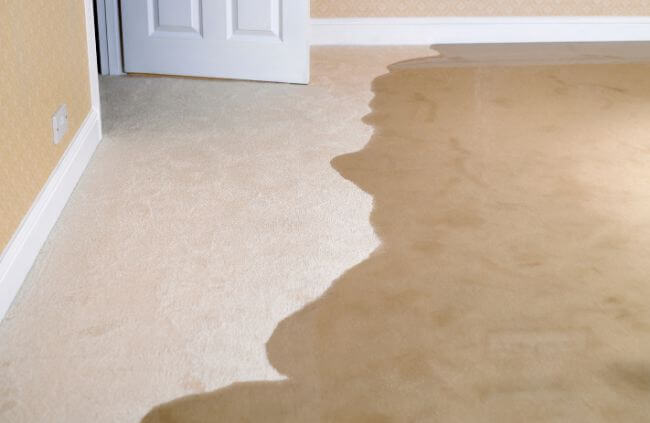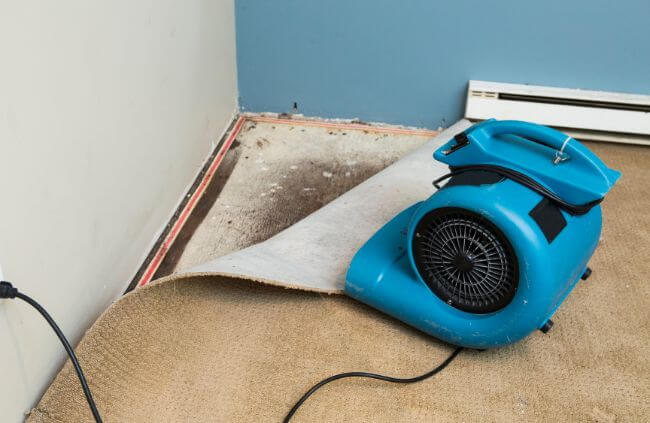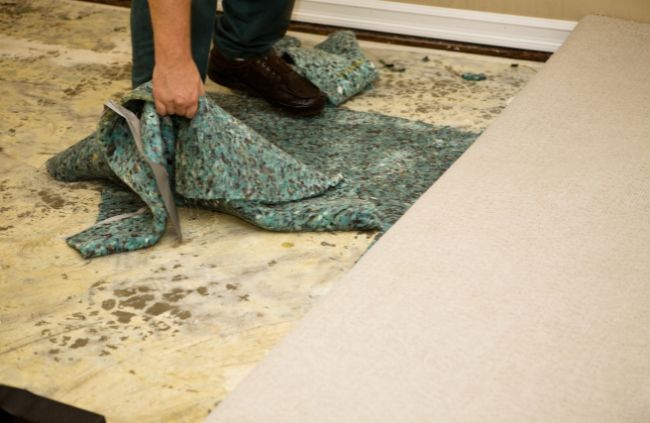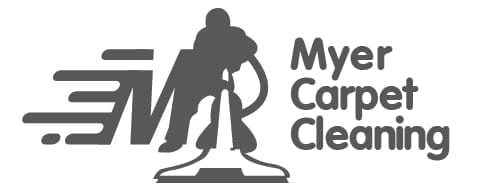Water damage can be a nightmare for any carpeted room. Whether caused by an unexpected flood or a sneaky water leak, the aftermath can leave your carpets soggy, smelly, and prone to mould growth. Not only does water ruin the appearance and quality of carpets, but a water damaged carpet can also lead to serious health risks if left untreated.
In this guide, we’ll walk you through everything you need to know to restore your water damaged carpet at home, from removing moisture to cleaning and sanitising it. Let’s dive in and tackle that wet carpet, step by step.

Understanding Water Damaged Carpet
Flooding or water leaks can wreak havoc on carpets in several ways. When excess water seeps into the fibres, it often soaks through to the carpet padding and sometimes even the subfloor, leading to extensive damage that can be costly to repair.
Here are some of the common effects of water damage:
Mould Growth
When carpets stay damp for long periods, mould and mildew can develop, releasing spores that affect indoor air quality. These can be harmful to your respiratory health and cause allergies or even asthma.
Weakened Carpet Fibres
The carpet fibres can weaken when exposed to water for extended periods, leading to premature wear, discolouration, and even stubborn odours.
Damage to Carpet Padding and Underlay
If water reaches the padding or underlay, it can cause them to deteriorate, reducing comfort underfoot and making the carpet less effective as insulation.
Impact on the Subfloor
In severe cases, water can seep through to the subfloor, leading to structural issues that may require professional repair.
Addressing water damage quickly and thoroughly is the best way to prevent these issues and restore your carpets to their former glory!
Tools Needed for Flooded Carpet Cleaning
Gathering the right tools is essential to deal with a water damaged carpet. Here’s what you’ll need:
- Wet/Dry Vacuum Cleaner: For extracting water from the carpet
- Towels: To absorb excess moisture
- Fans: To increase air circulation
- Dehumidifier: To remove moisture from the air
- Gloves and Safety Mask: To protect yourself from potential mould or bacteria
- Steam Cleaner: For deep cleaning and sanitising the carpet
- Baking Soda: To absorb moisture and odours
- Antibacterial Carpet Sanitiser: To eliminate bacteria and maintain hygiene

How to Clean a Carpet After Water Damage
If you’re dealing with a wet carpet, follow this step-by-step guide to remove moisture, clean, and sanitise your carpet effectively.
- Deal with the Cause of the Flood or Leak Immediately
Fixing the source of the water problem, such as a broken pipe or leaking roof, is essential to prevent further damage.
- Clear Out the Room
Remove all furniture, rugs, and other items from the room to access the carpet fully and allow it to dry thoroughly.
- Extract Moisture from the Carpet
Use a wet/dry vacuum cleaner to remove as much water as possible. Place towels on the carpet and press firmly to absorb any remaining moisture, replacing them as they become soaked.
- Air Out the Room
Open windows, turn on fans and use an air conditioner to circulate fresh air and speed up the drying process.
- Use a Dehumidifier
If moisture levels remain high, place a dehumidifier in the room to pull out excess water from the air and the carpet, reducing the risk of mould growth.
- Steam Clean Your Carpet Thoroughly
After the initial drying, steam cleaning helps eliminate bacteria and dirt embedded in the fibres. A good carpet steam goes a long way! It’s essential to follow instructions on your steam cleaner to avoid keeping your carpet wet. Steam cleaning is perhaps one of the most important steps to remove bacteria and mould spores.
- Apply Baking Soda to Remove Trapped Moisture
Sprinkle baking soda generously across the carpet and let it sit for at least an hour. Baking soda helps to pull excess moisture, absorb any remaining wetness and eliminate odours in the carpet.
- Allow the Carpet to Dry, Then Vacuum Thoroughly
After the baking soda has absorbed moisture, vacuum the carpet thoroughly to remove it and dry wet carpet, leaving the carpet looking and smelling fresh. The flooded carpet drying process is crucial.
- Apply an Antibacterial Carpet Sanitiser
To prevent bacteria growth, apply a carpet sanitiser according to product instructions. This step helps ensure the carpet remains hygienic for you and your family.
- Check for Damage to Carpet Padding, Underlay and Subfloor
Lift the carpet in a corner to inspect the padding, underlay, and subfloor for any lingering dampness or mould. If they’re damp, they may need to be replaced or professionally treated.
- Hire Professionals for Excess Damages
If the damage is extensive or the carpet remains damp, contact a professional carpet cleaner. They have the tools and expertise to perform water damaged carpet cleaning.
Tips on How to Prevent Future Water Damage
While dealing with a wet carpet after a flood or leak can be daunting, there are steps homeowners can take to minimise the risk of future water damage. Here are a few practical tips:
Inspect Plumbing Regularly
Checking your plumbing fixtures and pipes for any signs of wear, corrosion, or small leaks can help prevent significant water damage later. A minor drip today could lead to a burst pipe and soaked carpet tomorrow.
Install Water Leak Detectors
Water leak detectors are small devices that alert you at the first sign of a leak. Placing these near appliances like washing machines, dishwashers, and under sinks can be invaluable in preventing a minor issue from becoming a big one.
Use Waterproof Carpet Padding
Investing in waterproof carpet underlays can be an effective layer of protection. These pads are designed to resist moisture, helping to safeguard both the carpet and the subfloor below it.
Maintain Good Ventilation
Keeping rooms well-ventilated, especially in high-moisture areas, can help prevent condensation that might lead to carpet dampness over time. Opening windows, using exhaust fans, and occasionally running a dehumidifier can all contribute to a healthier indoor environment and reduce the chances of mould growth.
These preventive steps not only help protect your carpet but also save you from costly repairs down the road. Regular maintenance and proactive measures can make all the difference in keeping your carpets dry, clean, and comfortable for years to come.
Types of Water and How They Affect the Damage
Different types of water can have varying impacts on a water damaged carpet, affecting the required cleaning process:
Clean Water
This comes from rain or water supply lines and is the least contaminated, requiring only standard cleaning and drying procedures.
Grey Water
This includes water from dishwashers, washing machines, or sinks. Grey water may contain detergents, food particles, or dirt, making it essential to clean and sanitise thoroughly to avoid bacteria growth.
Black Water
Black water comes from sources like sewage or floodwaters from rivers. This water is highly contaminated and poses serious health risks. Carpets affected by black water should always be handled by professionals.
Understanding the type of water helps you decide on the appropriate cleaning method and whether professional help is needed.

Water Damaged Carpet FAQs
How long does it take for a wet carpet to dry?
A wet carpet can take anywhere from 12 to 48 hours to dry, depending on ventilation, humidity, and how thoroughly moisture has been removed.
Can a wet carpet cause mould growth?
Yes, if not dried and cleaned properly, wet carpets can develop mould and mildew growth within 24-48 hours.
Is it safe to clean a water damaged carpet myself?
It can be safe for minor water damage from clean water, but extensive damage or contaminated water requires professional cleaning.
Do I need to replace carpet padding after water damage?
Carpet padding may need replacement if it has been soaked and cannot be thoroughly dried or sanitised.
Why Choose Myer Carpet Cleaning for Flooded Carpet Restoration
When water damage is too severe to handle alone, Myer Carpet Cleaning is here to help. With specialised equipment and years of experience in flooded carpet cleaning, we can effectively restore your carpets, remove odours, and sanitise them for a healthier home.
Contact us today to book a professional flooded carpet restoration service and get your home healthy and back to normal again!
Wrapping Up Our Water Damaged Carpet Guide
Dealing with a water damaged carpet doesn’t have to be overwhelming. With the right tools and methods, you can tackle the damage yourself and restore your carpet’s comfort and cleanliness. But for serious cases, especially when dealing with grey or black water, professional help is the safest choice.
Myer Carpet Cleaning specialises in flooded carpet restoration, so you can trust us to handle water damage with expertise and care. Give us a call to restore your carpets to their former glory – and enjoy a fresh, clean home once again!
